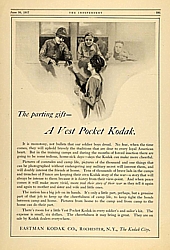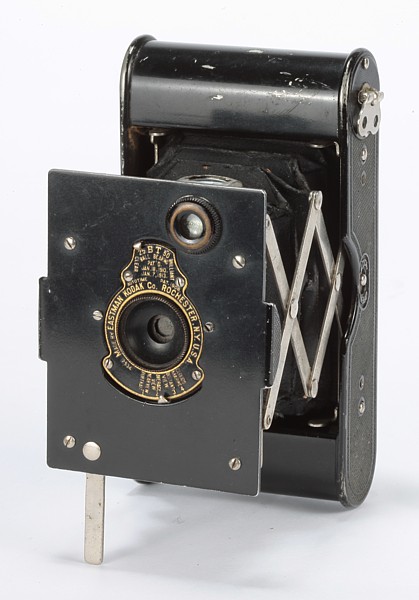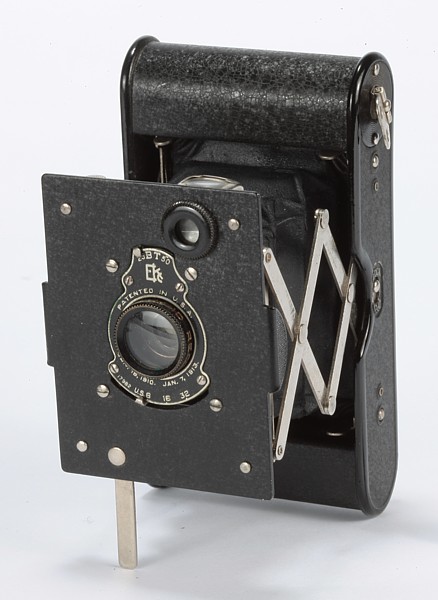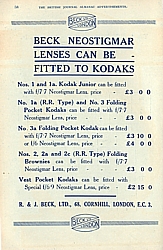Vest Pocket Autographic Kodak
Eastman Kodak Co.
| Name: | Vest Pocket Autographic Kodak |
| Type: | Folding (Strut) |
| Manufacturer: | Eastman Kodak Company |
| Country of Origin: | US |
| Construction: | The Vest Pocket Autographic Kodak is a small compact camera with collapsible bellows,
supported by scissor struts on each side. The version was introduced in 1915 when autographic film was introduced by Eastman Kodak. There were many design variations over the production period. |
| Plate / Film Size: | 127 rollfilm for pictures 1⅝" x 2½" |
| Dimensions (w x h x l): | |
| Movements: | None |
| Production Period: | 1915 - 1926 |
This page relates to the Vest Pocket Autographic Kodak camera made in the US, introduced in 1915 with the appearance of autographic film and continuing in production until at least 1926 (the last year that it appears in Kodak catalogues) and probably a few years beyond.
There were many design changes over the production period and various lenses were offered. The camera body was also made available to other lens manufacturers so that they could fit their own lenses, particularly in Europe. Many of the models were produced in the black enamel finish; however some models were produced in a Japan Crystal finish. Examples of both finishes are shown below.
 |
|
 |
The Vest Pocket Autographic Kodak camera was made in substantial numbers (approaching 2 million according to Coe [4]). It was particularly popular in the First World War, and is often referred to as "The Soldier's Camera". Indeed it was advertised as such by Eastman Kodak themselves. Click on the thumbnail to open a full size scan of the Kodak advert. |
Reference is made in all the pages relating to the Vest Pocket Kodak to a guide to this series of cameras produced by Jay Kay [12], which identifies the many different design variations that exist between the models. The book identifies a number of key characteristics that vary between models such as the faceplate design, shutter plate, side panels etc. I mention a number of the key characteristics that relate to each of the cameras in my collection, but a full list of the various characteristics based upon the Jay Kay's scheme can be found in the separate VPK Capture Sheet.
The cameras listed here are ordered by their serial number. Note that the production period for some models overlap.
| Model / Variant: | Plain enamel finish (Type S-04) |
| Lens: | Meniscus Achromatic |
| Shutter: | Ball Bearing No 0 |
| Date of this Example: | c1915 |
| Serial Number: | Serial 264288 on rear of support leg |
| Availability: |
|
| Inventory Number: | 343 |
<Photographs to be added>
Description
This is an example of the Vest Pocket Autographic Kodak with Meniscus Achromatic lens; the body has the plain enamel finish. The shutter surround (or Index Plate) carries number 5227 (Type S-04 Autographic in in Jay Kay's identification scheme [12]), apparently dating it to between 1914 and 1915, but the fact that this is an autographic model means that it was produced after March 1915.
There is no patent date information on the case cap (Type 1), but a latest patent date of 1913 is stamped on the front panel below the lens (Type 3).
The bellows are in good condition. The enamel finish is in very good condition, with wear only obvious on the autographic door and collar around the viewfinder lens, both of which have probably rubbed against the soft leather case.
~ # ~ # ~
| Model / Variant: | Japan Crystal finish (Type S-11a) |
| Lens: | Meniscus Achromatic |
| Shutter: | Ball Bearing No 0 |
| Date of this Example: | c1922 |
| Serial Number: | Serial 813203 on rear of support leg |
| Availability: |
|
| Inventory Number: | 319 |
<Photographs to be added>
Description
This is an example of the Vest Pocket Autographic Kodak with Meniscus Achromatic lens; the body has the Japan Crystal finish. The shutter surround (or Index Plate) carries number 12534 (Type S-11a in in Jay Kay's identification scheme [12]), apparently dating it to between 1916 and 1918. Note that Jay Kay's guide also suggests that this version was available in plain black enamel only (see #241 for an example).
This camera also has a latest patent date of 1921 (Type 4) and the later pattern of front panel (Type 4). It would therefore seem that this model in Japan Crystal finish must have been introduced later than the plain enamel finish model described by Jay Kay.
Note that the winder key is an open arc shape rather than the more usual 'B' shape. The aperture markings on this model are by description rather than by f-numbers. The bellows are in very good condition.
The Japan Crystal finish shows only minimal wear. The only other significant sign of wear is slight rubbing on the top curved edge and on the collar around the viewfinder lens. The camera has been cased for many years; it came in a high quality brown leather case that has vertical slits in the back to allow it to be carried on a belt and no strap.
~ # ~ # ~
| Model / Variant: | Plain enamel finish (Type S-11a) |
| Lens: | Meniscus Achromatic |
| Shutter: | Ball Bearing No 0 |
| Date of this Example: | c1918 |
| Serial Number: | Serial 897870 on rear of support leg |
| Availability: |
|
| Inventory Number: | 241 |

(Image © Amateur Photographer 2011, taken for an article by Ivor Matanle and reproduced with kind permission)
Description
This is an example of the Vest Pocket Autographic Kodak with Meniscus Achromatic lens; the body has the plain enamel finish. The shutter surround (or Index Plate) carries number 12534 (Type S-11a in in Jay Kay's identification scheme [12]), apparently dating it to between 1916 and 1918. Note that Jay Kay's guide also suggests that this version was available in plain black enamel only, as here, but #319 is an example with the Japan Crystal finish.
This camera also has a latest patent date of 1913 on the case cap (Type 2) and the later pattern of front panel (Type 4). It would therefore seem possible that this model in plain enamel finish may be earlier in date than the Japan Crystal version.
The bellows are in fair condition, but have started to degrade, breaking up at the fold edges and losing some of the surface material. The enamel finish is in good condition, with some damage to the top curved face and rubbing to the face of the viewfinder lens surround.
This camera came with its original two part slip box, finished in black and maroon, which is in excellent condition. note that on the top face the camera is named "Vest Pocket Autographic Kodak" while on the main face it is shown as "Autographic VPK".
~ # ~ # ~
| Model / Variant: | Plain enamel finish (Type S-15) |
| Lens: | Beck Neostigmar, f6.9, F=3.25in (fixed focus), serial 198945 |
| Shutter: | Ball Bearing No 0 |
| Date of this Example: | c1920 |
| Serial Number: | Serial 1106270 on rear of support leg |
| Availability: |
|
| Inventory Number: | 356 |
<Photographs to be added>
Description
This is an unusual example of the Vest Pocket Autographic Kodak as it is fitted with a Beck Neostigmar fixed focus lens; the body has the plain enamel finish. The quality of the lens means that this should probably be considered as a Special, but this form with shutter surround (or Index Plate) with number 15288 (Type S-15 in Jay Kay's identification scheme [12]), was normally fitted with the basic meniscus lens. This Index Plate number apparently dates it to between 1917 and 1921 (World War I era).
It is conceivable that the body was part of a batch sent to Kodak Ltd in Great Britain to be fitted with lenses by them or provided to other suppliers to fit their own lenses. More likely perhaps is that this was an upgrade to the standard camera carried out by Beck.
Note that the front panel is inscribed with f-numbers for the lens, making the aperture numbering (using the autotime scale) on the shutter plate itself redundant. This is a Type 4 plate, but as other similar examples have been recorded with the f numbering similarly inscribed, Jay Kay gives this pattern of face plate its own classification (Type 7).
Arguably the retrofit of a high quality lens such as this effectively converts the camera into a 'Special' model, but has been included here since in its original manufactured state it would be fitted with a Meniscus Achromatic.
The camera has a latest patent date of 1917 on the case cap (Type 3). It has a manufacturers plate on the rear that identifies Eastman Kodak as the maker (Type 1).
The bellows are in good condition, but with some wear on the folds. The enamel finish is in very good condition, with some rubbing to the raised edges. The camera came in a soft leather pouch case.
~ # ~ # ~
| Model / Variant: | Japan Crystal finish (Type S-21) |
| Lens: | Meniscus Achromatic |
| Shutter: | Ball Bearing No 0 |
| Date of this Example: | c1925 |
| Serial Number: | Serial 1604692 on rear of support leg |
| Availability: |
|
| Inventory Number: | 13 |
<Photographs to be added>
Description
This example of the Vest Pocket Autographic Kodak with the basic meniscus lens has Japan Crystal finish. The shutter surround (or Index Plate) carries number 16870 (Type S-21 in Jay Kay's identification scheme [12]), dating the camera to 1921 to the end of the production (nominally 1926).
This camera has a latest patent date of 1921 (Type 4) and the late pattern of front panel (Type 5). It is fitted with the and the additional bracing bracket joining the bottom pivots of the scissor trellis. The manufacturer's identification plate on the rear shows the maker as Canadian Kodak Company (Type 3).
The bellows are in good condition, although there is some separation on the underside. The Japan Crystal finish shows some wear, which is most obvious on the autographic door on the rear of the camera body.
~ # ~ # ~
| Model / Variant: | Japan Crystal finish (Type S-24) |
| Lens: | Rapid Rectilinear |
| Shutter: | Ball Bearing No 0 |
| Date of this Example: | c1925 |
| Serial Number: | Serial 1641506 on rear of support leg |
| Availability: |
|
| Inventory Number: | 125 |

(Image © Amateur Photographer 2011, taken for an article by Ivor Matanle and reproduced with kind permission)
Description
This example of the Vest Pocket Autographic Kodak is fitted with the Rapid Rectilinear lens; the body is in the Japan Crystal finish. The shutter surround (or Index Plate) carries number 17982 (Type S-21 in Jay Kay's identification scheme [12]), dating the camera to the period 1921 to the end of the production (nominally 1926). The lens type is marked around its outside edge in upper case (compare with #342). The aperture is marked using the Unified System (U.S.), marked as U.S. 8, 16 & 32.
This camera has a latest patent date of 1921 (Type 4) and the late pattern of front panel (Type 5). It is fitted with the& additional bracing bracket joining the bottom pivots of the scissor trellis. The manufacturer's identification plate on the rear shows the maker as Eastman Kodak Company (Type 2).
The bellows are in very good condition. The Japan Crystal finish shows very few signs of wear. The camera has an original leather case in fair condition but scuffed and marked through use, but it has done its job of protecting the camera body.
~ # ~ # ~
| Model / Variant: | Japan Crystal finish (Type S-24) |
| Lens: | Rapid Rectilinear |
| Shutter: | Ball Bearing No 0 |
| Date of this Example: | c1926 |
| Serial Number: | Serial 1744223 on rear of support leg |
| Availability: |
|
| Inventory Number: | 342 |
<Photographs to be added>
Description
This second example of the Vest Pocket Autographic Kodak is fitted with the Rapid Rectilinear lens; again the body is in the Japan Crystal finish. The shutter surround (or Index Plate) carries number 17982 (Type S-21 in Jay Kay's identification scheme [12]), dating the camera to the period 1921 to the end of the production (nominally 1926). The lens type is marked around its outside edge in small script; the lens surround is of a different (shallower) profile than #342 above.
In almost all other respects the camera is identical in layout to the previous example, although it has a later serial number. One subtle difference is that a washer is fitted behind the viewfinder lens collar.
The bellows are in very good condition. The Japan Crystal finish shows very few signs of wear. The camera has an original leather case in very good condition, which is embossed on the flap with the name of the camera and maker's name.
Notes
I have a fairly substantial collection of VPKs in their various formats and finishes. Refer also the Vest Pocket Kodak page for the initial non-autographic model and the Vest Pocket Kodak Autographic Special pages for the higher specification models (early non-autographic models and the more common autographic versions, including the highly desirable Compur / Tessar model).
![[x]](../../images/checked.png)
![[ ]](../../images/unchecked.png)
